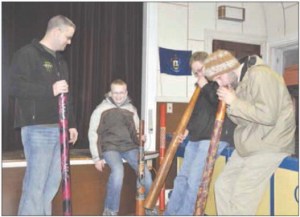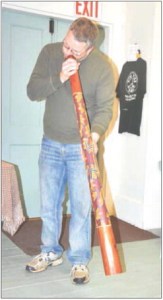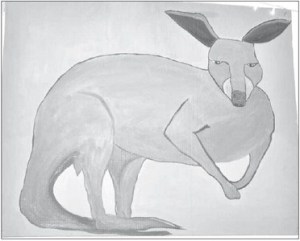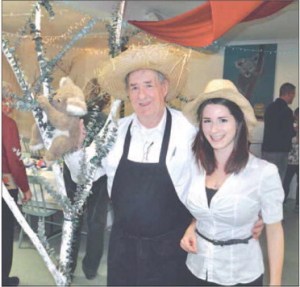Those attending dined on authentic Australian fare, including pumpkin soup with ANZAC (Australian-New Zealand Army Corps) biscuits, Australian meat pie, minted green beans and Lamington cake (a sweet cake with coconut) with ice cream and Australian Tropical tea.
During the meal, Erik Verrill entertained diners by playing a didgeridoo (also known as a didjeridu), a wind instrument developed by Indigenous Australians of northern Australia around 1,500 years ago and still in widespread use today both in Australia and around the world. It is sometimes described as a natural wooden trumpet, “drone pipe” or brass aerophone. After the meal, diners were able to try out a didgeridoo themselves, with four of the hollowed wooden instrutements made available. Termites create the hollow wooden pieces, tradionally made from eucalyptis.
Archaeological studies of rock art in Northern Australia suggest that the people of the Kakadu region of the Northern Territory have been using the didgeridoo for less than 1,000 years, based on the dating of paintings on cave walls and shelters from this period. A clear rock painting in Ginga Wardelirrhmeng, on the northern edge of the Arnhem Land plateau, from the freshwater period (that was begun 1500 years ago) shows a didgeridoo player and two songmen participating in an Ubarr Ceremony.
A modern didgeridoo is usually cylindrical or conical, and can measure anywhere from 3-10 feet long. Most are around four feet long. Generally, the longer the instrument, the lower the pitch or key of the instrument. However, flared instruments play a higher pitch than unflared instruments of the same length.
After the meal, Amy LeBlanc, the “Tomato Lady,” presented a slide show from an recent Australian visit. She described encounters with kangaroos, koala bears and other Australian flora and fauna, including “flying foxes” (large fruit bats), emus, camels, giraffes, kuckabara birds and dingos (dogs). Camels were originally introduced as pack animals in Australia in the mid-1880s, she said, and there now are roaming wild herds that actually outnumber the population in the Middle East. Rogue males will sometimes attack domesticated camels traveling with tourist outings.
She and her husband traveled on the eastern side of the continent – from Sidney to Adelaide, then to Uluru, Ellis Springs in the Outback, and Cairns, a subtropical area where they snorkeled on the Great Barrier Reef. Some of the coral was bleached out and dead from the warming ocean, she said. She shared traditional indigenous symbols and pointed out images of some of the the aboriginals’ sacred sites. LeBlanc had traveled to Austrialia for a world agriculture gathering, and said the next one will be in Istanbul, Turkey.
The next Passport Dinner will feature some history and foods of Russia. More information on this meal will be shared closer to the date of the next meal. Reservations for these informative dinners must be made in advance by calling 645-3676.




Comments are no longer available on this story